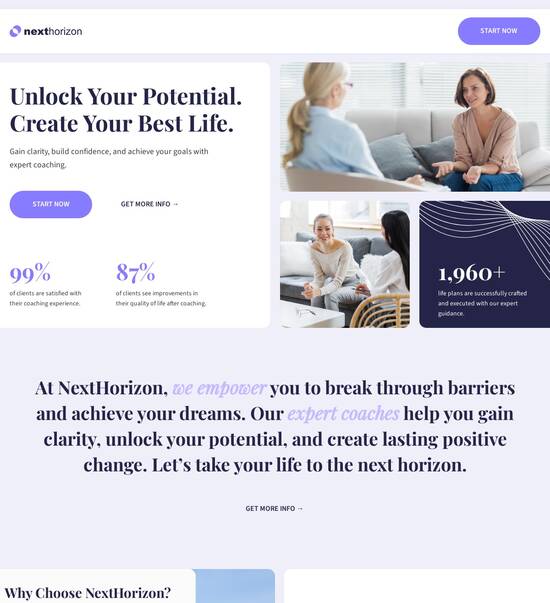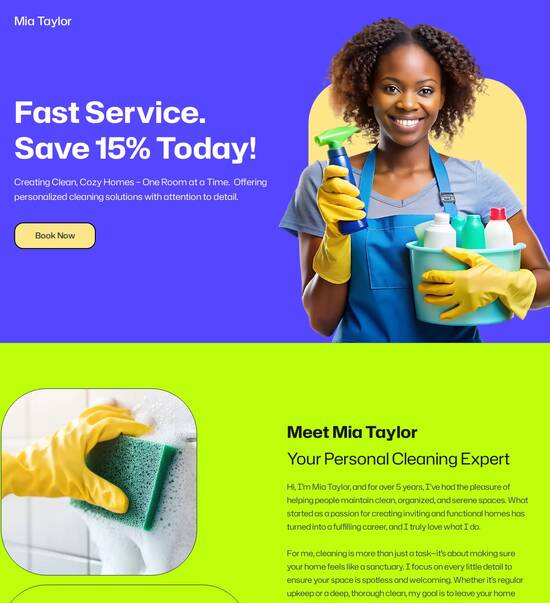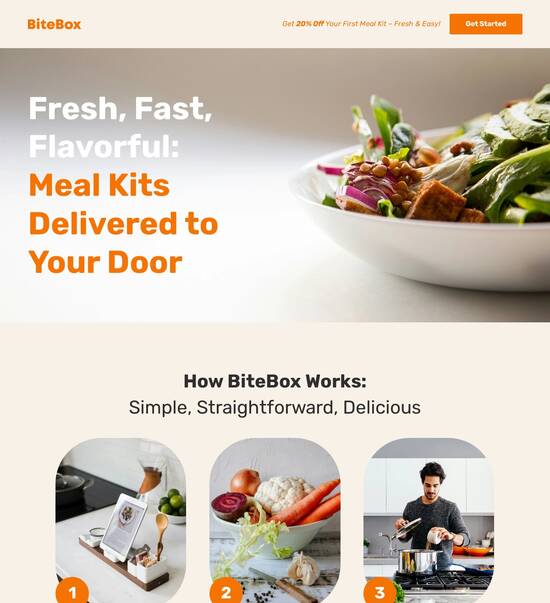
HTML page templates with app downloads
Explore Similar TemplatesAbout template
Manage your templates with app downloads and improve your conversion rates. Easily facilitate trust and transparency with your customers right now.
Recommended templates

Easy to build without coding
With the intuitive drag-and-drop builder, anyone on your team can create high-converting pages without any knowledge of code or design. Make enhancements to your landing page with custom widgets using Javascript, HTML/CSS, or third-party scripts.

Multiple layouts for any industry and goal
Select from 500+ landing page layouts built to boost conversions across industry-specific scenarios. Customize them by adjusting fonts, adding images, and generating on-brand content with the AI assistant. Quickly scale with Instablocks® and Global Blocks that you can save, reuse, and update globally.

Loads fast and looks polished on any device
Every template is responsive, which means they present professionally on any device and load blazingly fast with our Thor Render Engine. You can also power them up with Google AMP technology to deliver an unparalleled mobile experience and drive higher conversions.

Robust analytics & experimentation
Get real-time updates and reporting across all your devices, showing the number of visitors, conversions, cost-per-visitor, and cost-per-lead. Launch AI-powered experiments, run A/B tests, and use heatmaps to analyze user behavior, then optimize your landing page to maximize conversions.







Easy to build without coding
With the intuitive drag-and-drop builder, anyone on your team can create high-converting pages without any knowledge of code or design. Make enhancements to your landing page with custom widgets using Javascript, HTML/CSS, or third-party scripts.
Multiple layouts for any industry and goal
Select from 500+ landing page layouts built to boost conversions across industry-specific scenarios. Customize them by adjusting fonts, adding images, and generating on-brand content with the AI assistant. Quickly scale with Instablocks® and Global Blocks that you can save, reuse, and update globally.
Loads fast and looks polished on any device
Every template is responsive, which means they present professionally on any device and load blazingly fast with our Thor Render Engine.
Robust analytics & experimentation
Get real-time updates and reporting across all your devices, showing the number of visitors, conversions, cost-per-visitor, and cost-per-lead. Launch AI-powered experiments, run A/B tests, and use heatmaps to analyze user behavior, then optimize your landing page to maximize conversions.
All the features you need to build app download page html template
Explore more featuresLearn how to build instapage templates download
Frequently asked questions about html page download
Leading the way in building high-performing landing pages





Mobile app template html free download: Your ultimate how-to guide
In today’s digital landscape, having an effective landing page is crucial for driving conversions and optimizing marketing strategies. Instapage offers the most powerful landing page and conversion rate optimization (CRO) platform, designed to empower marketers from various sectors—including business services, education, and tech—with tools to accelerate their campaign performance and maximize ROI.
Understanding the basics of landing pages
Landing pages are specifically optimized to drive a specific action from visitors, whether that means signing up for newsletters, downloading apps, or making purchases. With Instapage, you'll have access to over 100 high-converting templates that allow you to create impactful pages that resonate with your target audience. This platform ensures that you don't need extensive coding expertise to develop or launch landing pages.
- Diverse template selection: Choose from multiple templates tailored for various industries to ensure ease of use and relevance to your marketing campaigns.
- Drag-and-drop functionality: Utilize intuitive builders that allow for quick customization and real-time edits, enabling you to focus on creativity rather than technical details.
- Instant publishing: Launch your landing pages without delays, ensuring you can promptly respond to marketing trends or campaign shifts.
Step 1: Creating high-performance landing pages
The first crucial step in leveraging Instapage's platform is to utilize its intuitive page builder. It allows marketers to design stunning, user-friendly landing pages tailored to their audience. This flexibility in design ultimately influences conversion rates positively.
- Use the pre-built elements: Integrate lead generation forms, images, and videos directly from the library to enhance engagement and reduce bounce rates.
- Target different segments: With dynamic text replacement, customize the landing page's messaging to reflect the unique needs of different audience segments.
- Optimize for mobile: Since a significant number of users operate from mobile devices, ensure that the landing page is responsive and offers a seamless user experience across all devices.
Step 2: Optimization strategies
Utilizing built-in A/B testing and heatmap features can significantly uplift your landing page optimization efforts. Instapage's detailed analytics dashboard provides insights into which elements are performing well, allowing marketers to make informed decisions based on data.
- Run A/B tests: Experiment with different headlines, images, and CTAs to discover which versions yield the highest conversions.
- Analyze heatmaps: Leverage heatmap tools to understand how visitors interact with your page elements, helping you to make necessary adjustments.
- Refine your strategy: Continuously assess and iterate on your strategies based on analytical insights, ensuring sustained improvement over time.
Step 3: Engagement through personalization
Engagement can be maximized when your content is personalized for each audience segment. Instapage allows marketers to design experiences tailored to specific demographics, significantly boosting conversion potential.
- Leverage dynamic elements: Implement personalized calls-to-action and messaging that directly aligns with visitors' needs and behaviors.
- Utilize audience-specific metrics: Track and analyze engagement at the audience level to further refine your approach and enhance effectiveness.
- Align ads with landing pages: Use AdMaps to ensure that your ads lead potential customers to landing pages with relevant content, increasing the likelihood of conversion.
By following these steps, marketers can fully utilize the capabilities of Instapage to drive better results from their campaigns, ensuring that every dollar spent yields maximized returns.
Start transforming your campaigns today by experiencing the comprehensive features that Instapage offers. Sign up now and take your landing pages to the next level for unparalleled campaign success.
People also ask about html template app
HTML page template with app downloads
Understanding HTML page templates for app downloads
HTML page templates are pre-designed web pages that provide a structure for developers to create websites quickly and effectively. These templates serve as frameworks that can be filled with content, images, and functionalities based on specific requirements. For app developers, having an engaging and aesthetic landing page is crucial. It not only enhances the chances of downloads but also establishes brand authority and trust among potential users.
Templates are particularly important in the context of app downloads because they allow developers to focus on their core functionalities without spending excessive time on design. A well-structured template can highlight the app's features, showcase reviews, and include effective calls to action, all of which can influence a user's decision to download. Moreover, using templates can speed up the development cycle, enabling rapid prototyping and testing.
Tailored HTML templates can be created to address the needs of different audiences. For example, a gaming app may require a vibrant and dynamic layout, whereas a finance app might benefit from a more understated and professional design. Understanding user preferences is vital to increasing conversion rates.
Key features of app download HTML templates
When creating an HTML template for app downloads, certain features should not be overlooked, as they contribute to user engagement and SEO performance. Meta tags are a fundamental component, providing search engines with essential information about the page's content. Tailored tags can help optimize the website for relevant keywords, making it easier for users to find the app in search results. By utilizing unique title and description tags, developers can increase visibility and attract more potential users.
Essential functions within the template enhance user experience significantly. JavaScript can be employed to create interactive elements like sliders and pop-ups that inform users without overwhelming them. Furthermore, ensuring that the template is responsive is crucial for accessibility, meaning that it should adapt smoothly to various screen sizes from mobile devices to desktops, maintaining usability across platforms.
JavaScript functionality to enhance interactivity.
Responsive design functions that adjust to user devices.
Usage of CSS to maintain aesthetic coherence across platforms.
Additionally, ensuring broader browser compatibility allows the template to reach the most significant number of users possible. Thorough cross-browser testing is therefore essential. This process helps identify discrepancies and resolves issues that might arise, ensuring that the website performs optimally regardless of the user's preferred browsing environment.
Leveraging modern design techniques
Adopting contemporary design techniques can significantly enhance the effectiveness of an HTML page template for app downloads. One useful method is the implementation of lazy loading through the use of libraries like iolazy. Lazy loading ensures images and resources are only loaded when they enter the viewport, helping to speed up initial page load times. This improvement in performance often translates to enhanced user experience and lower bounce rates.
Video backgrounds can also serve as an effective strategy for engaging users right away. When used correctly, they can provide a vivid illustration of what the app offers, showcasing features and functionalities in an eye-catching manner. However, balance is key; it is crucial to ensure that videos do not slow down the loading process, as a lagging website can deter potential downloads.
Explanation of lazy loading and its benefits in enhancing page speed.
Guidelines for embedding videos without affecting load times.
Color theory should not be overlooked when designing app landing pages. Color schemes that align with the app's branding can evoke the right emotional response from potential users and influence their decision-making process. For example, blue often signifies trust, while red can evoke urgency. Careful consideration of these psychological effects can enhance a user's engagement with the content.
Lastly, font selection plays a vital role in readability and aesthetics. An app template should use web-safe fonts that are easy to read and enjoyable. Pairing fonts appropriately can also add a polished touch to the design, ensuring that the content remains user-friendly and engaging.
Structuring your template: key layout features
Effective layout structure is essential for any HTML page template focused on app downloads. The header is the first point of interaction for users and should be designed thoughtfully. Including a clean logo, succinct navigation, and a prominent call-to-action can set a positive tone right from the start. The header should not overwhelm the user but instead clearly lead them to the core functionalities and benefits of the app.
Another crucial aspect is the footer, which often gets undervalued. However, it can serve as a valuable resource for users seeking additional information. The footer should include contact information, important links, and social media connections, as well as legal disclaimers. A clear and informative footer can enhance the overall usability of the page.
Elements of a successful header (logo, navigation, etc.).
Key components for footers: contact info, social media links, and legal notices.
Finally, column layouts can greatly enhance content organization. Properly utilizing columns allows developers to present various app features, benefits, and user testimonials clearly. It's essential to ensure responsiveness in the column layout; as the screen size changes, content must adapt without compromising clarity or aesthetics.
Design elements to enhance user engagement
Incorporating design elements that foster user engagement can drastically affect download rates. Visual hierarchy is one such element. By utilizing headings and subheadings strategically, developers can create a structured narrative that leads users through the template seamlessly. White space, or negative space, is equally important; it helps separate various elements without cluttering the page. Appropriate alignment and spacing guide user focus naturally toward the desired actions.
An effective content strategy is also vital for crafting persuasive app descriptions that resonate with potential users. Making use of bullet points can aid with quick scanning, ensuring users easily comprehend key features without feeling overwhelmed by large bodies of text. Additionally, integrating testimonials and user reviews elevates credibility, providing social proof that encourages downloads.
Crafting persuasive app descriptions.
Utilizing bullet points for easy scanning.
The role of testimonials and user reviews in conversion.
Images play a critical role in conveying the essence of an app and must be chosen carefully. Selecting high-quality images that reflect the app's utility and align with brand identity is crucial. Furthermore, incorporating alt text enhances accessibility while boosting SEO performance, ensuring users who rely on screen readers can interact with the content effectively.
Enhancing performance with advanced features
To facilitate an optimal user experience, understanding the DOMContentLoaded event is essential. This event signifies that the initial HTML document has been completely loaded and parsed, precision when executing scripts is crucial to ensure that enhancements like animations or modifications occur after the page is ready. Adhering to best practices for script loading can minimize delays, thereby improving perceived performance.
Despite the careful design of templates, common issues may arise. Testing for layout discrepancies across different devices is vital to maintaining usability. In addition, download button malfunctions can deter users; addressing these common problems in the development phase will ensure that the final product meets user expectations and provides a smooth experience.
Best practices for optimizing script execution for faster loading times.
Solutions for layout issues across devices.
Creating an effective download panel
The download panel serves as the final gateway for users ready to download the app, and several best practices can enhance its effectiveness. Incorporating a clean and visually appealing layout is essential. The color strategy should align with the overall page design while ensuring that download buttons stand out. Providing clear instructions on how to download the app, including details about availability across platforms, can eliminate confusion and facilitate smoother downloads.
Moreover, optimizing user flow is crucial in the transition from the landing page to the app download page. An uncomplicated and user-friendly experience can significantly enhance conversion rates. Utilizing analytics tools to track user behavior can provide invaluable insights into how the download process can be refined. Continuous iterations based on data can lead to meaningful improvements in user journeys, ultimately increasing download rates.
Harnessing the power of HTML builders
HTML builders have revolutionized the way web developers approach template creation. By enabling users to design and customize HTML templates without extensive coding knowledge, these tools streamline the development process. Builders often come equipped with various features, such as drag-and-drop functionality, pre-built components, and comprehensive libraries of templates focused on app downloads.
The benefits of using an HTML builder extend beyond ease of use. They allow for rapid customization, enabling developers to adapt templates to their requirements quickly. Additionally, many builders integrate seamlessly with various marketing tools, allowing for enhanced functionality such as A/B testing, tracking performance metrics, and fine-tuning landing pages to optimize for conversions.
Ease of customization.
Speed in development.
Integration capabilities with various tools.
Looking ahead, it's clear that HTML templates will continue to evolve. With emerging trends in artificial intelligence and automation shaping the future of web development, we'll likely see tools becoming even more intuitive and capable of providing tailored experiences for diverse users. This transformation promises to simplify the process of creating compelling app download pages, ultimately benefiting marketers and developers alike.
Ready to skyrocket conversions?
Supercharge your ad campaigns with high-performing landing pages
Get started














